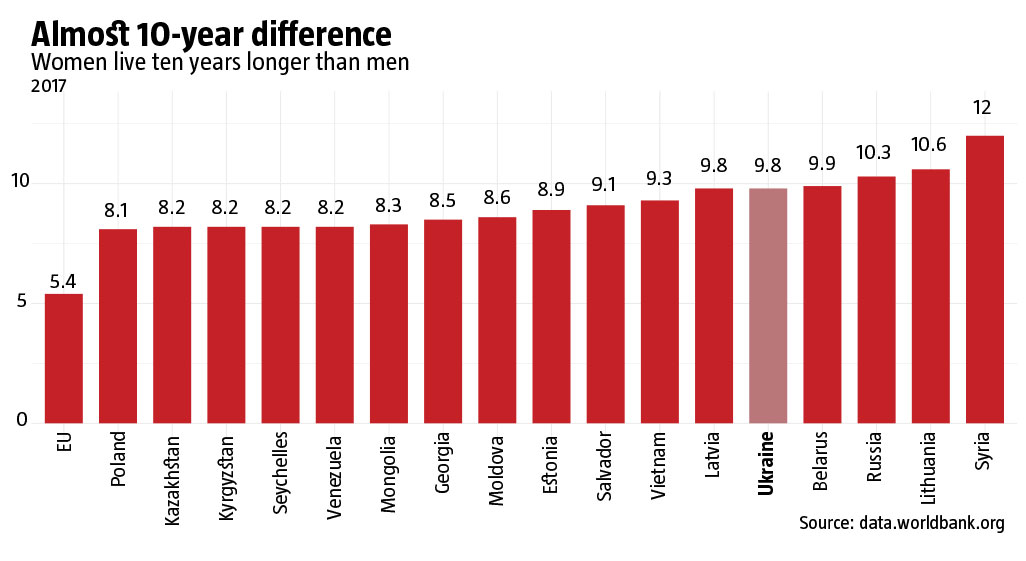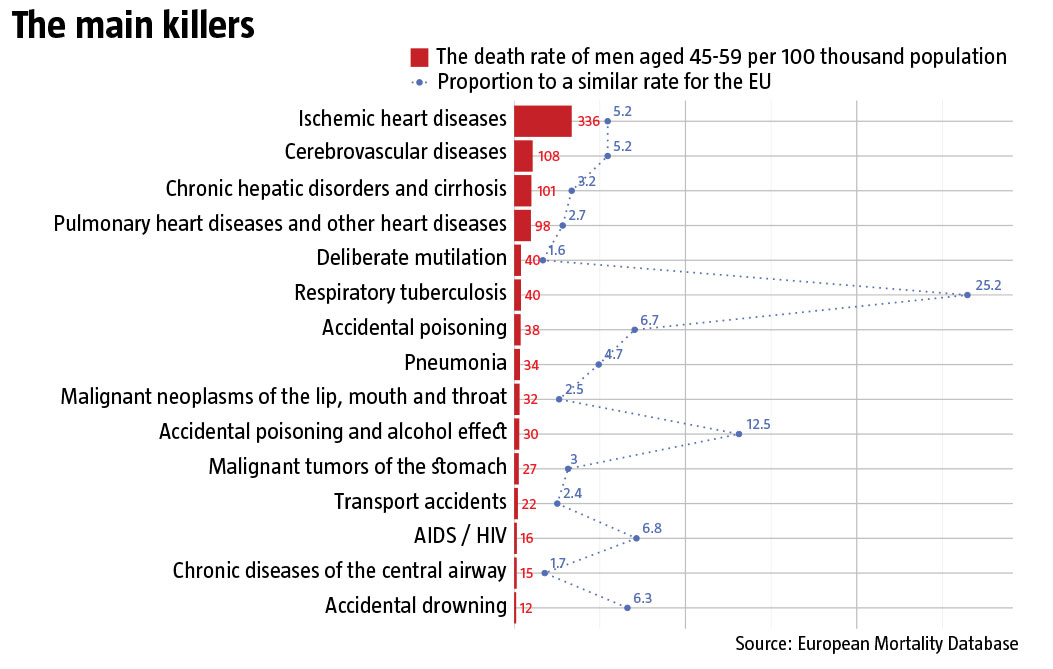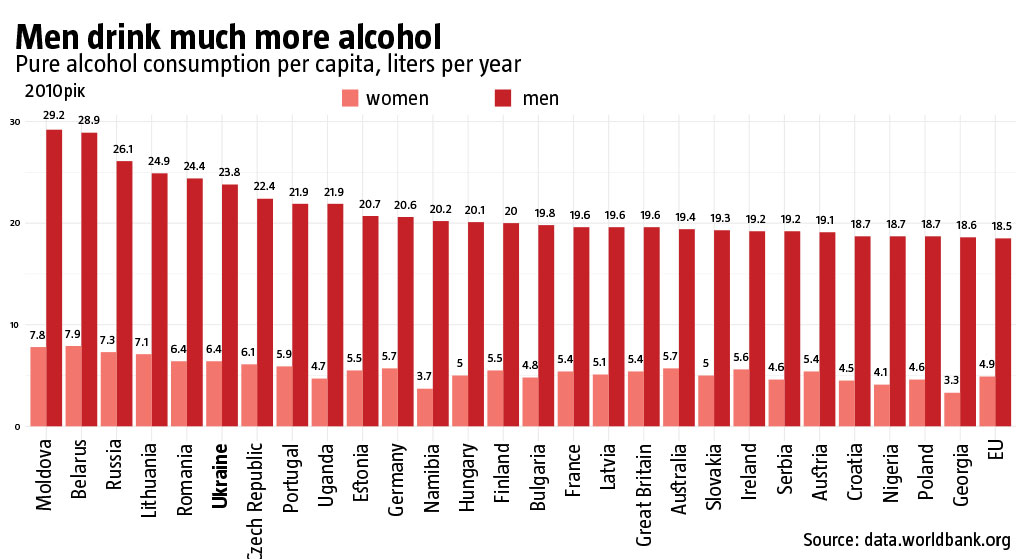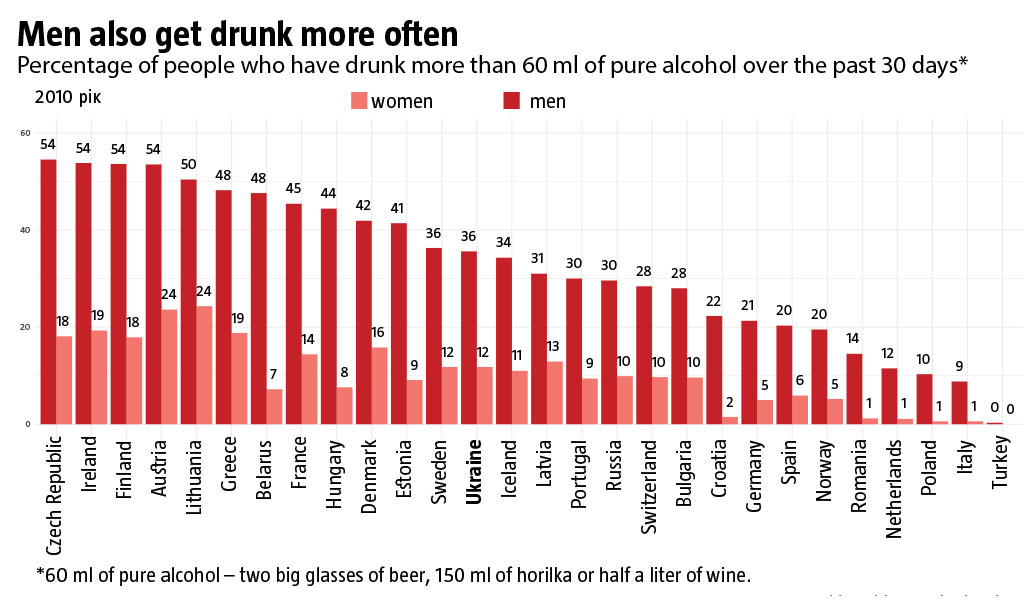There are few people who manage “to live happily ever after and to die on the same day”. But it seems that Ukrainians do not have such chances at all: life expectancy of men in our country is 10 years less than of women. In almost all countries, women live longer than men, but in Ukraine this difference is one of the largest in the world. Even more striking it is only in our former socialist camp partners – in Russia, Belarus, Lithuania and Latvia. In the EU countries the difference is 5 years.
So what is the reason and what to do to live longer, happier and not leave your wife as a young widow?
RELATED ARTICLE: Ulana Suprun: “Raising awareness is our great responsibility”
LIFE EXPECTANCY IN UKRAINE
Life expectancy in Ukraine is 72 years, and it is quite short. The average life expectancy in the EU is nine years longer – 81. We are ranked sixth among countries of Europe and Central Asia.
In European countries, life expectancy has steadily increased since World War II. However, there was no stable trend in the post-Soviet countries, now it grew and then declined. As a result, we are still at the level of the 1960s by this rate.
The short life expectancy of Ukrainians is related to the premature death of men. Life expectancy of women in Ukraine is also low, but it is not so dramatically different from that of European countries. For example, in comparison with the EU, men in Ukraine live 11 and women only 7 years less. So the reasons are not only in poverty and Chornobyl, these problems are usually ascribed to. Something our men do wrong unlike men in Europe. And in something that makes considerable odds men around the world differ from women (see Almost 10-year difference).

MORTALITY FACTORS
To understand why Ukrainian men die so early, we have observed the causes of premature deaths in the 45-60 age group and compared them with the causes of deaths in EU countries.
The most common factors of death for men of this age are blood vessel diseases (heart attacks, strokes, hypertension, cardiomyopathy), cancer, traumas and gastrointestinal diseases (see The main killers).

For most reasons, mortality rates in Ukraine are three to four times higher than in EU countries. This means that in the EU, middle-aged men die less, and for various reasons, which are more or less evenly distributed. And we can clearly see that premature mortality is primarily caused by several diseases.
Big Four Diseases. In Ukraine, among most common lethal factors are ischemic heart diseases, cerebrovascular diseases (when there is a lack of blood supply to the brain), chronic hepatic disorders, “pulmonary heart” and other heart diseases. The death rate from cardiovascular diseases is of particular concern, as it is more than four times higher than in EU countries and takes the most lives. What is the reason? No, it is not the specifics of the healthcare system (which, incidentally, is being effectively reformed) to blame, because then there would be no difference between men and women. The reason is that men have a different lifestyle from that of women: they smoke more, drink alcohol, do not care about their fitness, forget to take medication… And though invisibly, but relentlessly, all this pushes them in their late fifties to the coronary care unit on a drip.
Cancer. With regard to cancer, the EU-Ukraine ratio is still normal: Ukrainian men are 1.6 times more likely to die from cancer. This is many, but not significantly, for all the causes of mortality. Some cancers (such as leukemia or brain tumors) cannot be prevented. For other diseases, the risk of developing skin, lung, larynx, esophagus, pancreas, or rectal cancers can be significantly reduced. You should avoid prolonged sun exposure, smoking, drinking alcohol and consuming fried foods.
Alcohol.Accidental alcohol poisoning is 12.5 times more common among Ukrainians than Europeans. Chronic hepatic disorders and cirrhosis are three times more frequent. This leads us to two thoughts: we have problems with alcohol consumption; not all alcohol in our market is of good quality and legal, we will discuss this soon. Ukrainians are also more often accidentally poisoned and drowned as a result of drinking alcohol while resting near water bodies.
Reasons there might not be. Ukrainians are much more likely than Europeans to die from accidents, infectious diseases, respiratory diseases and diseases of genitourinary system and of skin. What is common in these tragedies is that they could be much fewer, because there are, for example, safety belts, labor protection, vaccines, asthma treatment under the program “Available medication”, antibiotics, and sunscreen. Perhaps we have been used to despising caution, perceiving it as the opposite of manliness?
Tuberculosis. Tuberculosis deaths per 100,000 populations are relatively insignificant, but this figure is more than 25 times higher than in the EU. This can be explained by the activity of tuberculosis in prisons, HIV and widespread antibiotic resistance in Ukraine.
DRINKING SELDOM, BUT IF THERE IS NO TOMORROW
Alcohol is worth talking about in more detail. If you estimate the consumption of official alcohol (one that State Statistics Service of Ukraine records in statistics on production, sales and imports), Ukrainians drink less of it than citizens of almost all EU countries. So obviously there is a high proportion of shady and smuggled drinks in Ukraine. According to the WHO (2014 and 2018), between 36% and 50% of alcohol consumed is sold without excise duty. In 2010, Ukraine was ranked sixth in the world by the amount of alcohol consumed by men (see Men drink much more alcohol).

According to the WHO report for 2014, Ukraine is the most risky pattern of alcohol consumption among all countries of the world. This means that not only do we drink a lot, but we do it wrong:
Drink much at a sitting. There is no safe dose of alcohol, but there is an amount that the body’s enzymes can neutralize relatively quickly. It is equivalent to 130 ml of wine, 300 ml of light beer, 40 ml of strong alcohol (horilka), but it also depends on the person’s weight. If you drink more, then alcohol and its derivative – toxic acetic aldehyde – last longer, and this is harmful. For example, a liter bottle of light beer contains double maximum allowable rate of consumption for men. If one drinks the equivalent of 60 grams of alcohol at a time, the WHO qualifies it as a “heavy intoxication”.
Often get drunk. Almost half of men who drink alcohol regularly get drunk. Among women, this is only one in five. There are also 10% more non-drinkers among Ukrainian women than men. In addition, drunkenness increases rate of injuries through violence.
Drink in public places. Drinking on playgrounds and benches is prohibited by law, but it does not stop anyone. We can witness this in almost every park in the evening.
Often drink without after-bites. The consequence of it is metabolic syndrome: the development of insulin resistance and, eventually, the type II diabetes, obesity or the accumulation of visceral (internal) fat, atherosclerosis. If you drink wine or beer with your meal, the likelihood of developing this syndrome is reduced. But if you drink the same beer, for example, instead of dinner, your stomach increases, your blood glucose levels rise, your blood pressure increases, and your age is shortened.
Drink unevenly. The amount of alcohol that people in general drink is distributed differently. Consume evenly every day: for example, a glass of wine at dinner. Or much at a sitting: drink a lot on Fridays or go to a bender. According to the World Bank, in Ukraine, comparing with other European countries, the first way is peculiar to a small number of people: 36% among men, 12% among women. That is, the majority of the population drinks unevenly, consequently, all harm of alcohol falls to those who do it rarely, but as they say, heartily, as if there is no tomorrow. Most prone to binge drinking are divorced or single men aged 30-60.
THE WAY ALCOHOL KILLS
Alcohol consumption increases the risk of atherosclerosis, heart failure, hypertension, alcoholic cardiomyopathy, chronic hepatic disorder, esophageal cancer, pancreas and rectum cancers, dementia and traumatism. Every third Ukrainian who died of heart disease suffered from alcoholic cardiomyopathy. If you drink (half a liter of wine or a liter of beer or half a glass of horilka in two hours), it is very likely that there will be arrhythmia, shortness of breath and even pain behind the sternum. Regular binges or drinking increase the risk of stroke. Alcohol is incompatible with a number of drugs: those for cardiovascular diseases, hypertension, painkillers, anti-diabetics, antidepressants, cholesterol-lowering drugs (statins). Therefore, the medicine for diseases that kill Ukrainians cannot be taken at the same time with alcohol.
The body's reaction to alcohol has a clear “gender inequality”. Women have an indirect J-type dependence of high blood pressure and susceptibility to other cardiovascular diseases on the amount of daily alcohol. It is even “useful” for women to drink a little (equivalent to 15 ml of pure alcohol). It lowers the pressure, but larger amounts of alcohol instead raise it. Immediately we should warn that the word “useful” – in quotation marks, because at the same time alcohol increases the risk of breast cancer, and there is no safe dose of alcohol at all. But men, starting at 10 ml a day, are at risk of hypertension and the more amount of the alcohol, the higher it is. Among those who drink, hypertension affects every second man and every fourth woman. That is, the former drink more, and it beats them more than women.
Alcohol-related public health problems are inherent in developing countries or those that have suddenly become wealthy and have extra money to drink (see Men also get drunk more often).

MOST SMOKERS DIE SHY OF LUNG CANCER
Smoking 25 times increases the likelihood of lung cancer, a disease with a very poor prognosis. But tobacco, like alcohol, leads slowly to a hospital bed. Lung cancer becomes a “fashionable” diagnosis 20 years after smoking has become fashionable in society. Most Ukrainian smokers do not live up to it, as it develops near the age of 70, while people die from coronary heart disease or stroke. That is why new generations of young smokers (youngsters in our country start smoking early – at the age of 16-18) do not think about the possible consequences.
In Ukraine, 47% of men and 14% of women smoke regularly. By the percentage of smokers we are in the top 20 among the countries of the world. We also have a significant gap between men and women in smoking rate: it is much smaller in European countries. Men tend to smoke more often than women. So we have another reason for the premature death of men.
Active and passive smoking relentlessly leads to chronic obstructive pulmonary disease (COPD), a disease that is rarely diagnosed in Ukraine but is often experienced. COPD is manifested as shortness of breath, persistent bronchitis or emphysema. Difficult work of lungs leads to “pulmonary heart” – already mentioned the main cause of premature death of Ukrainians.
About a quarter of heart diseases develops through smoking. It doubles the risk of coronary heart disease or even quadruples it. It also shifts the cholesterol balance to the unhealthy side and thus causes atherosclerosis. Smoking triggers free-radical processes in the body – continuous bombardment of cells, DNA, blood vessels with very reactive molecules. As a result, the blood supply to the heart or limbs deteriorates. Smoking can even lead to peripheral vascular disease when vessels constrict and weaken the blood supply to the legs or kidneys. Smoking increases your risk of cancer. In Ukraine, the rates of ischemic heart diseases, cerebrovascular diseases, lung diseases and gastric, larynx, rectum and gall bladder cancers caused by smoking are 15-20% higher than in the EU.
The main thing is that smoking begins to kill intensively “in a team” with other bad habits, or, in the medical language, – factors that can be influenced. That is, being a slender smoker who runs and eats salads every day, you can reach old age, but it will not work if you smoke, lie on the couch with beer and have obesity (see The difference in rate of smokers among men and women).

EVERY OTHER IS NOT AWARE OF HIS HIGH PRESSURE
High pressure is unpleasant, risky, but often manageable. The causes of hypertension are an increasing age, excessive consumption of salt (over a teaspoon a day in all products), stress, obesity, fat on the stomach, excessive consumption of alcohol – that is all we have in Ukraine. Even poor nutrition of the mother during pregnancy, of the baby in the early years of life, or excessive one in adulthood can cause breakdown of pressure regulation mechanisms.
In Ukraine, 33% of people have high blood pressure or take medicines that control it. In this case, women are more aware of their hypertension and are being treated. Every other man does not know that he has hypertension (only one in four women is ignorant). In the young category, hypertension is more common in men than in women. Prior to the beginning of the medical reform, there was no routine check of pressure and weight when visiting a therapist in Ukraine, meaning that many people did not receive a timely diagnosis. “No one is healthy now,” is quite often what really sick people think and do not receive treatment.
However, it is still worse. The World Bank report states that treating hypertension is a problem. Half of those who have known about hypertension and who have been prescribed the medication either have not taken it or have not adhered to doses and frequencies. Among those diagnosed with hypertension, only half have been advised to reduce their salt intake and reduce stress, and 37% have been advised to lose weight. Only in half of cases smokers with hypertension have been advised to quit smoking. And these lifestyle tips are paramount steps to controlling high pressure. A similar pattern is among those who have high cholesterol and blood glucose levels.
That is, men who smoke, have visceral fat, enjoy alcohol and salty snacks, are very vulnerable to high blood pressure. And at the same time, they often do not know about it, and if they do, they do not treat it.
RELATED ARTICLE: Art of prioritization
POT-BELLY AS A CONSEQUENCE OF LIVING YEARS
37% of men and 47% of women over 50 have at least one chronic illness. That is, the latter are more often ill, but rarely die prematurely. This is due to both your own health and physiology. Throughout the world, men are less likely to use medical services and carelessly follow a doctor's guidelines, so that their chronic illnesses remain largely untreated. Women are more cautious and diligent in this matter.
However, in duels with chronic illnesses, women have a significant advantage: they are more or less protected by estrogens before menopause, and in menopause, hypertension rather than cardiomyopathy or heart attack, as is typical for men, occurs. Hypertension can be managed fairly effectively with medication and diet. With heart attacks, everything is much more complicated. Women experience a heart attack differently than men, and this is a significant cause of death due to it. However, if it is not lethal, then women recover of it better.
32% of men are overweight and 12% are obese. In women, these figures are 25% and 24%, respectively. More than 40% of obese people are not aware of their problem. But weight is not all, there is more to it. The predisposition to cardiovascular diseases, the main killers of Ukrainians depends on the fat distribution in our body. If it is placed under the skin and mostly on the buttocks and thighs, it is not terrible. If it is on the trunk, between the internal organs and looks like “I only have a belly, otherwise I am thin”, then the heart and brain are in danger. This fat is called visceral, and it is a powerful source of inflammation, the cause of cholesterol imbalance, atherosclerosis, the type II diabetes, erectile dysfunction and the development of cardiovascular diseases. The place of fat deposition is due to heredity and sex, as well as hormonal background. Men are more prone to visceral obesity than women. However, if a woman's waist is larger than her thighs, she is also at risk of contracting the disease. The bulging belly of a man is not a natural consequence of years lived, but evidence of a constant lack of movement and excess of calories. And although this type of figure is quite common in our country and is not condemned by society as much as a woman's weight, you should not put up with it.
By
Andriy Kosetskiy, sociologist and big data analyst
Daria Ozerna, biologist and scientific journalist
Follow us at @OfficeWeek on Twitter and The Ukrainian Week on Facebook

